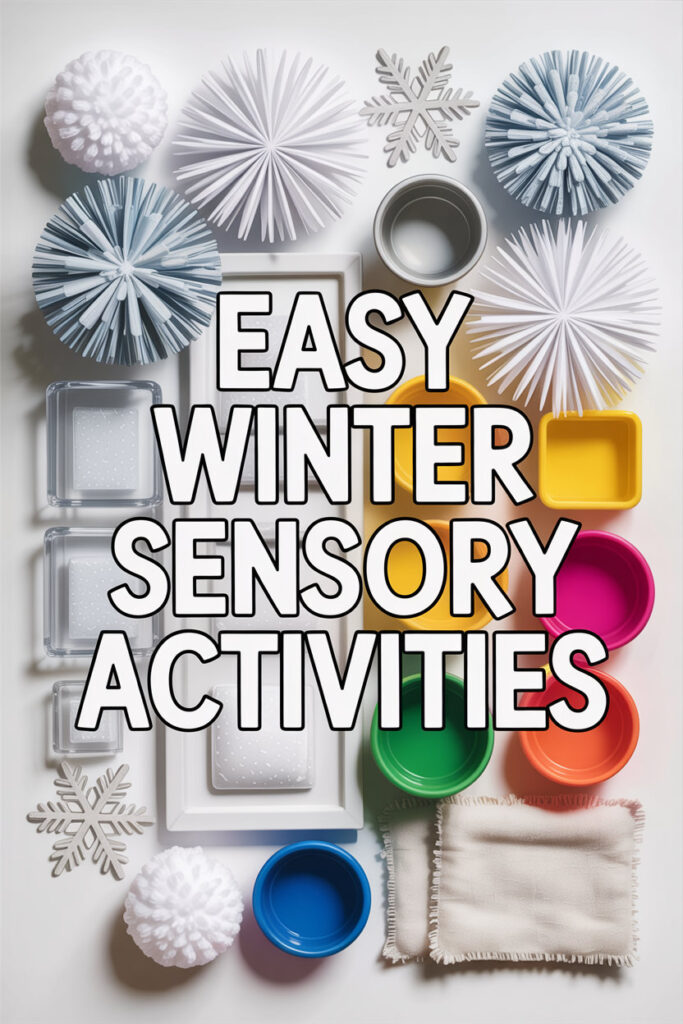Lazy Easy Winter Sensory Bin Ideas
There’s something almost cinematic about winter mornings with little ones—soft light spilling across the floor, the scent of warm cocoa nearby, and tiny hands eager to explore anything that sparkles, crunches, or glows. When the world outside turns frosty, sensory bins become an easy way to bring that magic indoors, transforming ordinary materials into small wonders that feel as enchanting as the first snowfall.
These winter sensory bin ideas are designed with both beauty and practicality in mind. Think icy blues, shimmering textures, cozy naturals, and play invitations that look like they were curated for a seasonal editorial spread. Beyond their charm, they nurture fine-motor skills, encourage imaginative storytelling, and offer calming, hands-on engagement—especially on days when cabin fever starts creeping in.
Whether you’re introducing your toddler to icy treasures, setting up a snowy small-world scene, or simply creating a soothing bin of cool-toned textures, each idea here balances developmentally rich play with a sense of wintertime wonder. Consider this your guide to crafting sensory experiences that feel intentional, enchanting, and perfectly aligned with the season’s quiet beauty.
Heads up: This post may include affiliate links. As an Amazon Associate, I earn from qualifying purchases—at no extra cost to you. Full privacy policy and disclosure here.
How to Set the Winter Mood
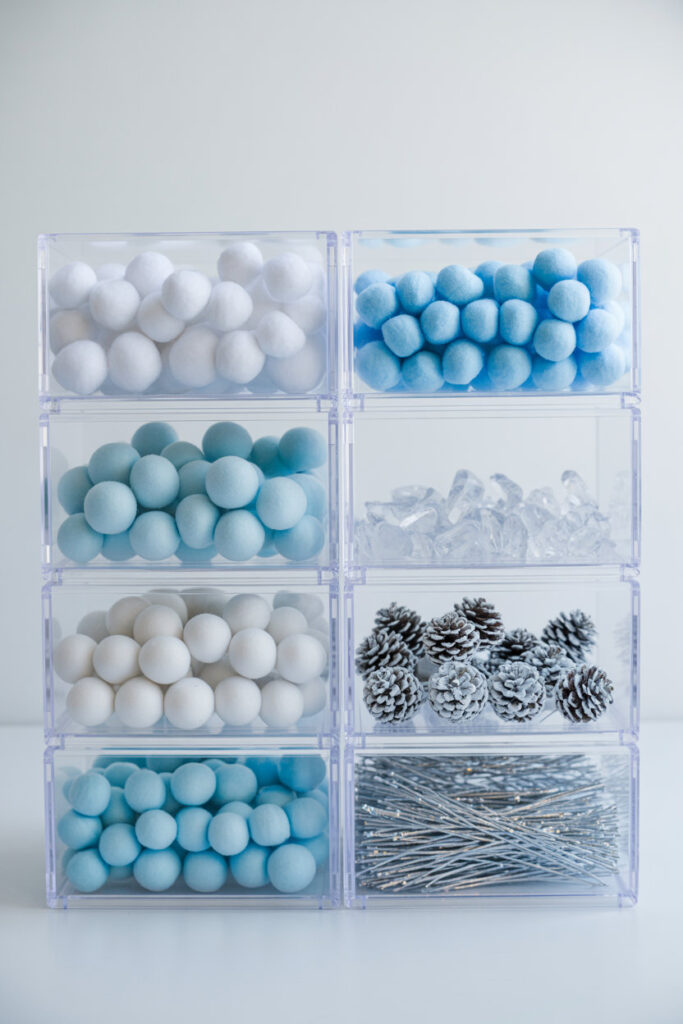
Winter sensory play feels most magical when the atmosphere around it is intentional. Creating a seasonal mood doesn’t require elaborate décor—just a few thoughtful choices that echo the quiet beauty of snowy days. Start with a soft color palette: icy blues, creamy whites, silver accents, and gentle neutrals that instantly evoke frosted mornings. Spread a scarf, neutral cloth, or simple placemat beneath your bin to frame the play area and give it a polished, styled look.
Next, choose your base materials. Instant snow, white rice, cotton batting, glass beads, water, or dyed chickpeas can all create wildly different winter themes. Rotate textures throughout the season to keep the experience fresh and engaging. To elevate the setup (and extend engagement), add simple tools—wooden scoops, silicone cups, child-safe tongs, or stacking bowls. These not only add visual charm but also build fine-motor coordination.
If you want to amplify the ambiance, dim the lights slightly and bring in safe glow elements like LED tea lights placed out of reach. Even the smallest glow can make a sensory bin feel like a tiny winter wonderland. And for parents who love a streamlined setup, consider keeping a labeled tub of “winter sensory materials” nearby so everything is ready for quick, dreamy play whenever inspiration strikes.
Helpful tools: clear storage bins, instant snow powder, Montessori scoops and tongs, silicone sorting cups.
Winter Sensory Bin Ideas
Snowy Small World Village
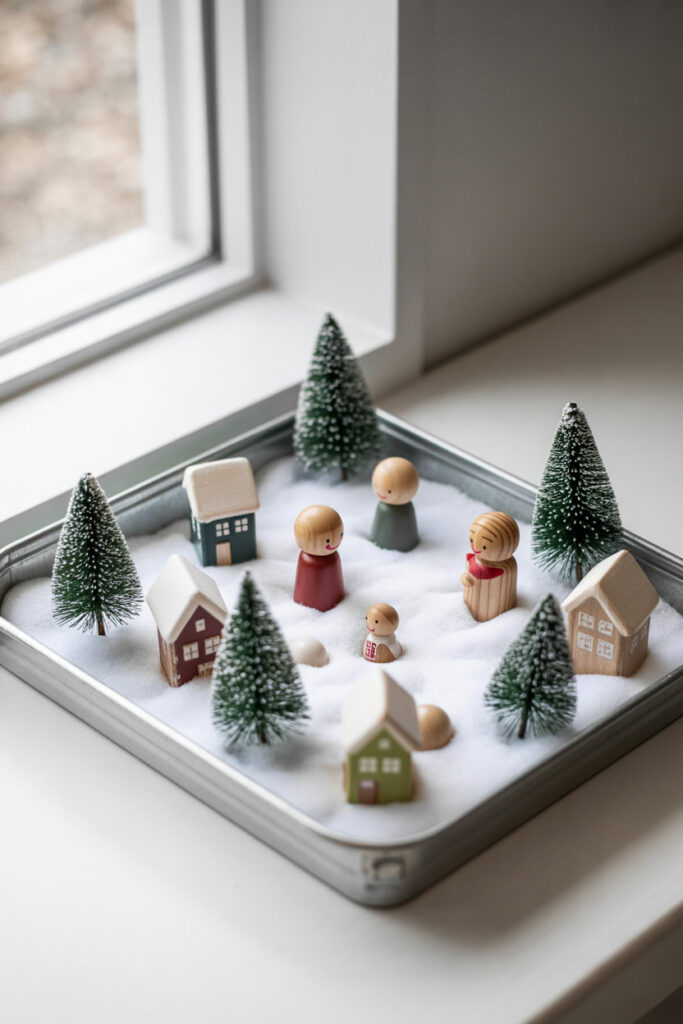
This bin captures the quiet charm of a winter town at dawn—soft, white bases paired with miniature details that invite storytelling. Fill your bin with white rice, instant snow, or cotton batting to create a snowy landscape. Add wooden peg people, tiny houses, and bottle-brush trees to turn the setup into a cozy winter village your toddler can explore and rearrange.
This kind of small-world play naturally encourages language development, imaginative thinking, and gentle fine-motor work as little hands move pieces through the snow. Keep accessories simple and uncluttered so the scene feels airy and peaceful, just like a real winter morning.
Helpful tools: wooden peg dolls, mini bottle-brush trees, wooden scoops.
Arctic Animals Discovery Bin
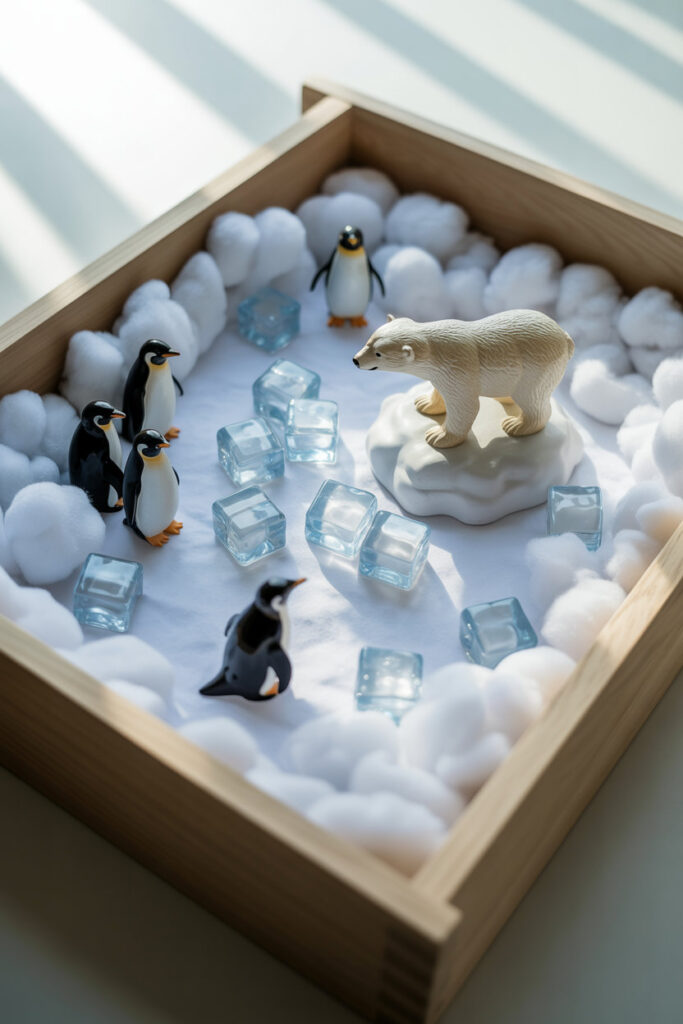
This bin feels like stepping into a tiny arctic expedition—cool tones, crisp textures, and gentle, icy sensory moments. Start with a base of cotton batting, reusable ice cubes, or real ice blocks placed in a shallow bowl inside the bin. Add arctic animal figurines such as polar bears, seals, puffins, or penguins to create a miniature frozen habitat your child can explore.
The mix of cold elements and soft materials offers a compelling sensory contrast that encourages descriptive language and curiosity about winter wildlife. Kids love making tracks in the “snow,” balancing animals on icebergs, and pretending to rescue animals from drifting floes. It’s a simple setup with big imaginative payoff.
Helpful tools: arctic animal figurines, reusable ice cubes, sensory tongs.
Frozen Treasure Hunt
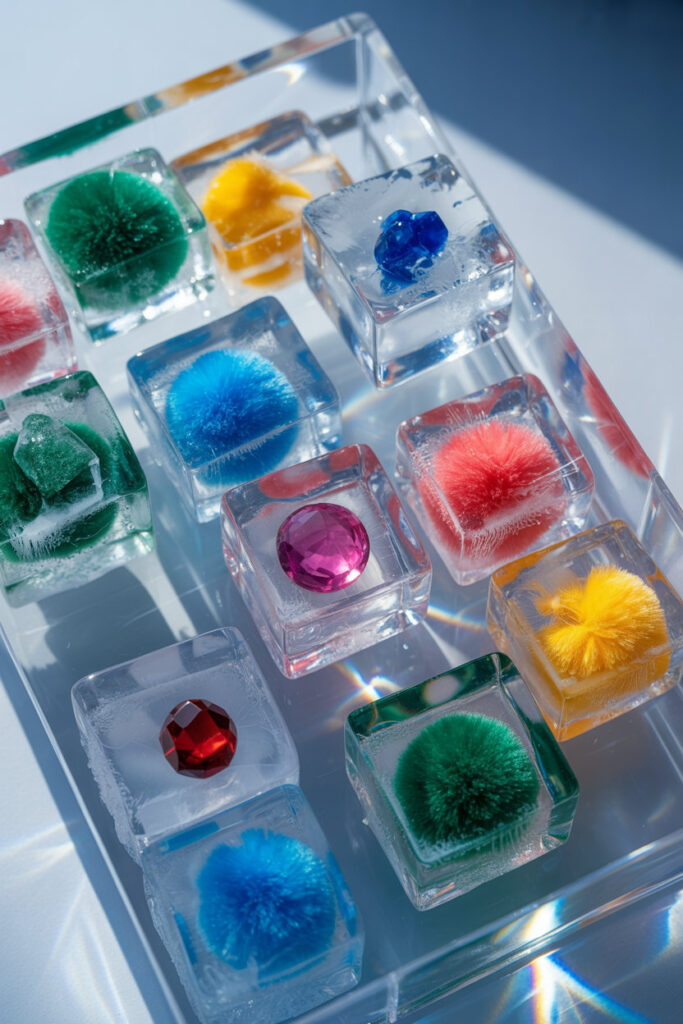
This bin brings a touch of winter magic to fine-motor play, turning everyday objects into sparkling frozen “treasures.” Freeze small pom-poms, buttons, or sensory gems inside ice cubes using silicone trays. Once frozen, scatter the cubes across a shallow bin and offer your child warm water in a squeeze bottle, a spoon, or kid-safe tongs to help melt or uncover each hidden treasure.
The slow reveal encourages patience, problem-solving, and plenty of awe as colors begin to peek through the ice. You can make the experience more dramatic by adding a layer of cold rice or instant snow beneath the cubes, so each discovery feels like unearthing something rare and glittering.
Helpful tools: silicone ice trays, fine-motor tongs, kid-safe squeeze bottle.
Winter Wonderland Pom-Pom Scoop Bin
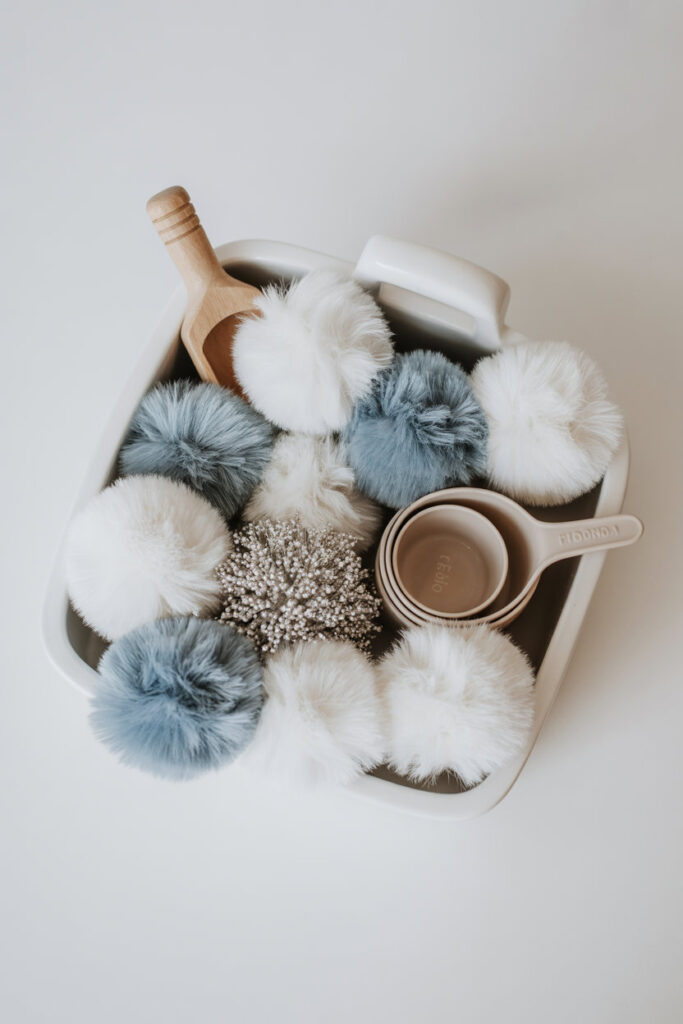
This bin is soft, bright, and wonderfully simple—perfect for days when you want something magical without a long setup. Fill your bin with white, silver, and icy-blue pom-poms in a mix of sizes. Add a few scoops, bowls, or silicone cups, and you instantly have a wintery play invitation that feels like a snowy landscape made for little hands.
The lightweight textures make scooping, sorting, and pouring especially satisfying. Toddlers instinctively categorize by size or color, building early math and fine-motor skills without even realizing it. The gentle color palette keeps the activity calm and soothing, giving it the same quiet charm as a winter afternoon indoors.
Helpful tools: winter pom-pom assortments, silicone sorting cups, fine-motor scoops.
Ice Castle Construction Zone
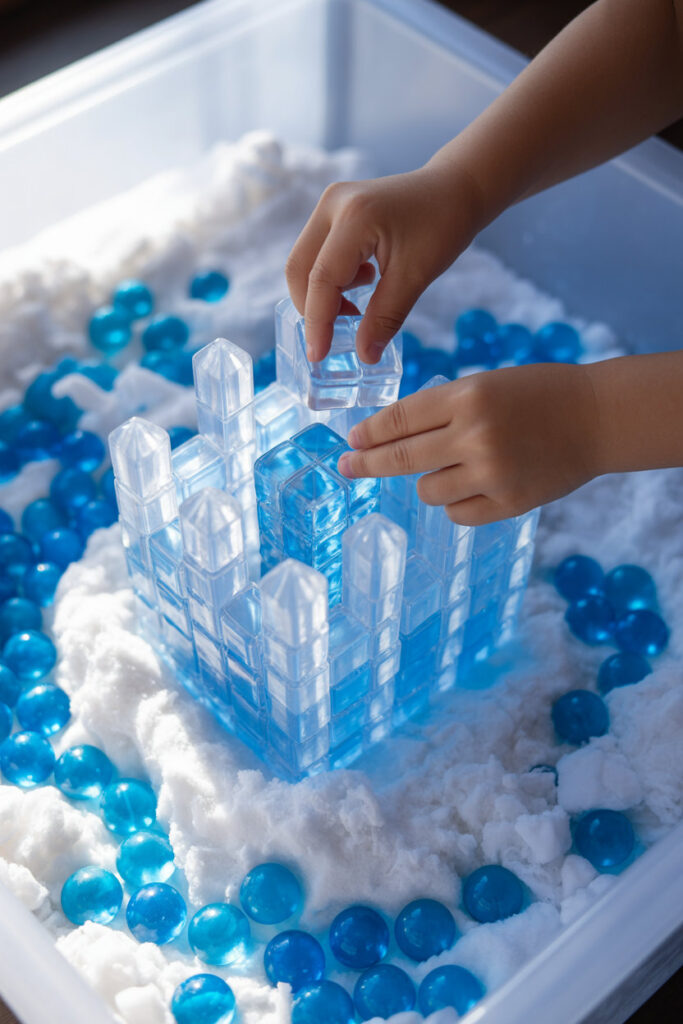
This bin turns winter play into a miniature architectural adventure. Start with a layer of instant snow, cotton batting, or white rice to create a frosty foundation. Add reusable ice blocks, translucent building bricks, blue glass beads, or clear stacking cubes to inspire your child to build their own sparkling “ice castle.” The contrast between cold elements and smooth, translucent pieces gives the whole setup an enchanting, crystalline look.
Kids naturally experiment with balance, height, and symmetry as they stack and rearrange their icy structures. It’s an invitation to explore early engineering principles in a way that feels whimsical rather than instructional. For an extra sensory layer, offer a small bowl of warm water to gently melt pieces together or separate stuck blocks.
Helpful tools: translucent building bricks, blue glass beads, sectioned sensory trays.
“Hot Cocoa Shop” Dramatic Play Bin
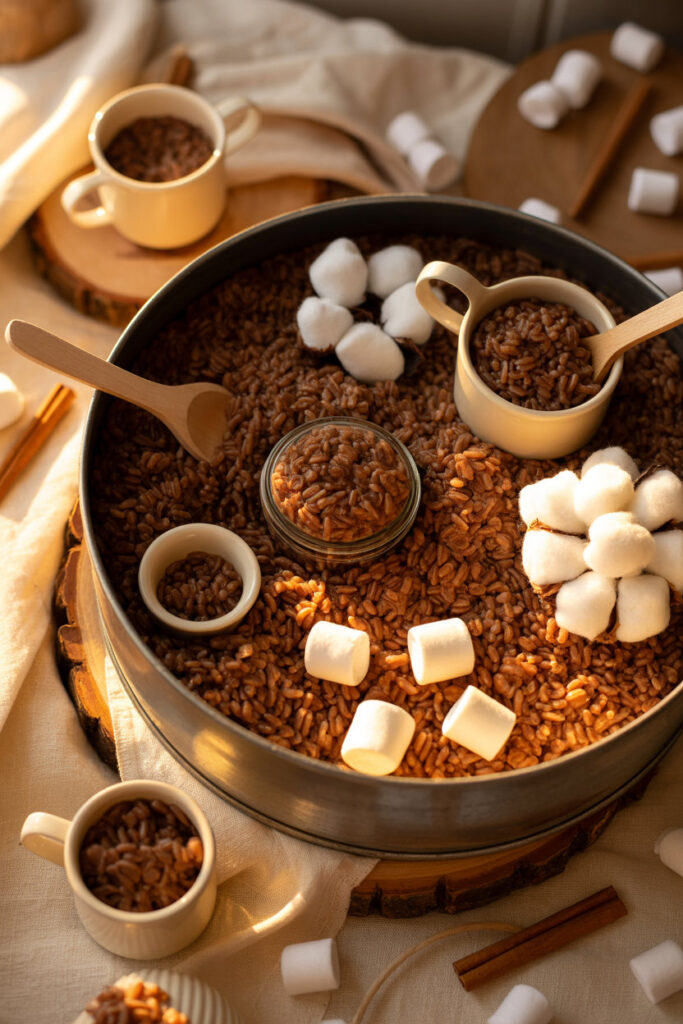
This cozy bin brings a warm, café-inspired twist to winter sensory play. Start with a base of brown rice or cocoa-colored oats to mimic hot chocolate powder. Add cotton-ball “marshmallows,” mini cups, wooden spoons, scoops, and silicone muffin liners. The result feels like a tiny hot cocoa stand—inviting, imaginative, and perfect for children who love pretend play.
As kids scoop, stir, serve, and “taste,” they dive into rich dramatic play that builds language skills, sequencing, and storytelling. The warm tones offer a comforting visual break from icy winter palettes, making this a perfect snow-day activity. For added charm, include cinnamon sticks or whole cloves in a sealed container so children can enjoy a festive winter scent safely.
Helpful tools: pretend play mugs, wooden spoons, silicone cupcake liners.
Polar Bear Bath Bin
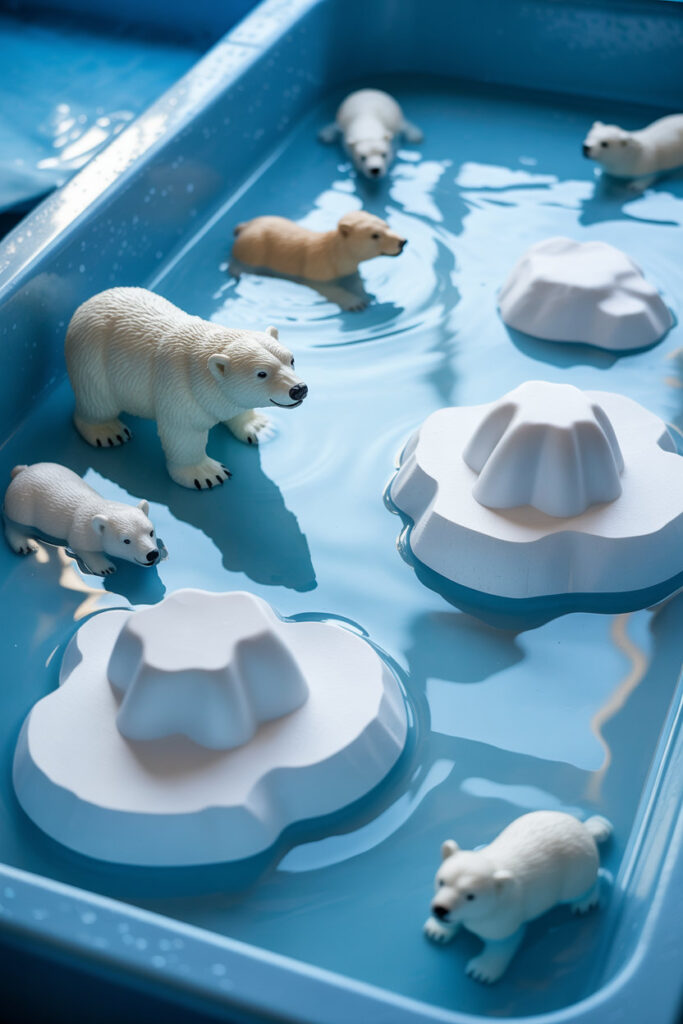
This refreshing, water-based setup captures the gentle chill of winter without overwhelming little hands. Fill the bin with cool (not cold) water tinted a soft blue using food coloring or bath tablets. Add foam “icebergs,” washable polar bear toys, and a small ladle or scoop. The floating pieces create a calm, gliding effect that instantly feels like a polar bay.
Kids love giving the animals “baths,” guiding them across the water, and rescuing them from drifting ice. It’s a soothing, sensory-rich experience that supports language development and cause-and-effect learning. Keep a warm towel nearby to wrap animals—or tiny hands—when play ends.
Helpful tools: washable animal toys, water play scoops, foam sheets.
Sparkle Snow Sensory Bin
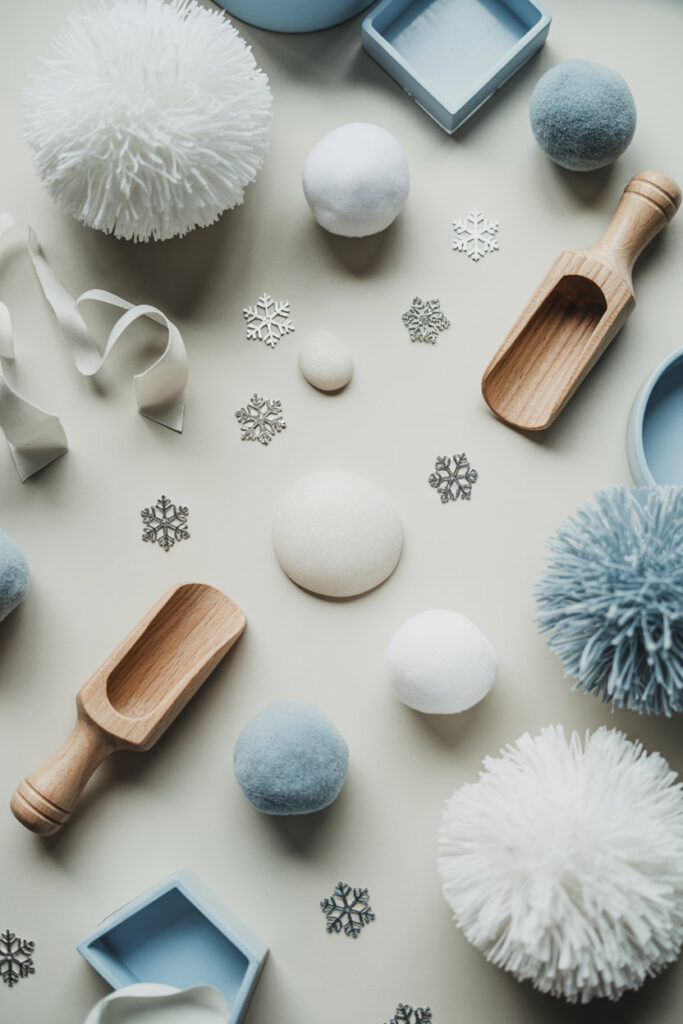
This bin channels the shimmer of fresh snowfall—the kind that glows when sunlight hits just right. Use instant snow as the base, then fold in a pinch of biodegradable glitter or silver confetti for a luminous effect. Add scoops, funnels, and translucent cups to encourage gentle digging and pouring.
The cool, fluffy texture is irresistible, and the sparkle element makes it feel like a real winter morning on the ground. Children explore volume, sensory contrast, and imaginative story prompts (“Is it fairy snow? Moon snow?”). It’s simple, beautiful, and endlessly engaging.
Helpful tools: instant snow, biodegradable glitter, sensory funnels.
Winter Nature Bin
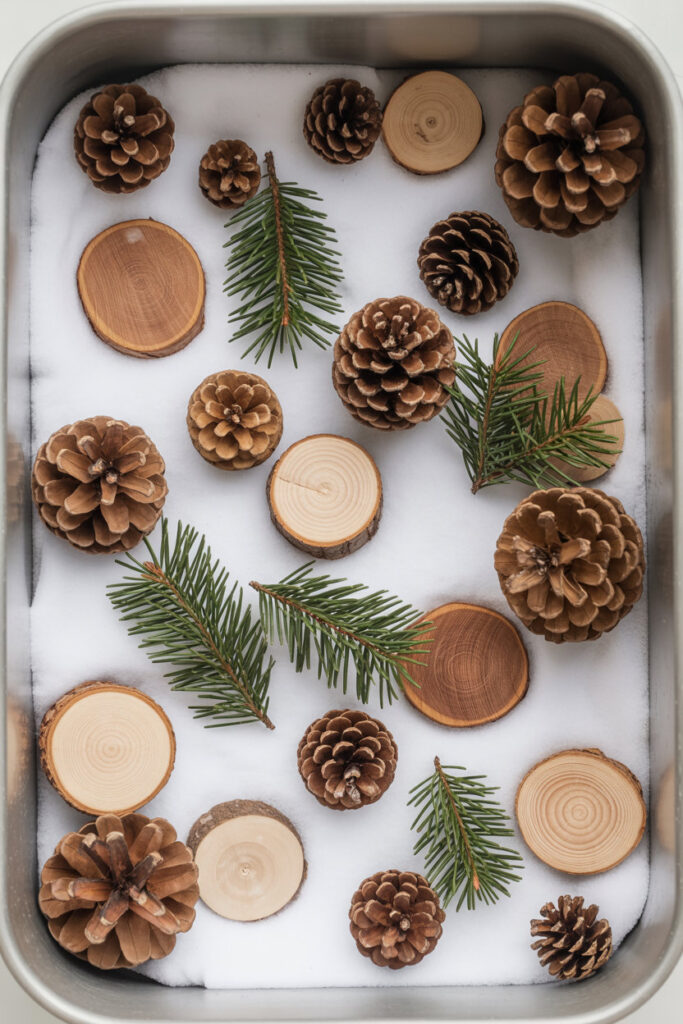
This earthy, woodland-inspired bin brings a touch of the outdoors inside. Gather pinecones, evergreen clippings, acorns, snowflake confetti, and smooth wooden discs. Spread them across a base of white rice or cotton batting to mimic a snowy forest floor.
Children enjoy exploring textures, comparing shapes, and creating simple nature scenes. This bin is wonderfully grounding—perfect for kids who thrive with calm, tactile play. The natural scents add a subtle sensory layer that feels fresh and wintery.
Helpful tools: pinecones, snowflake confetti, wooden discs.
Gingerbread Cookie Sensory Bin
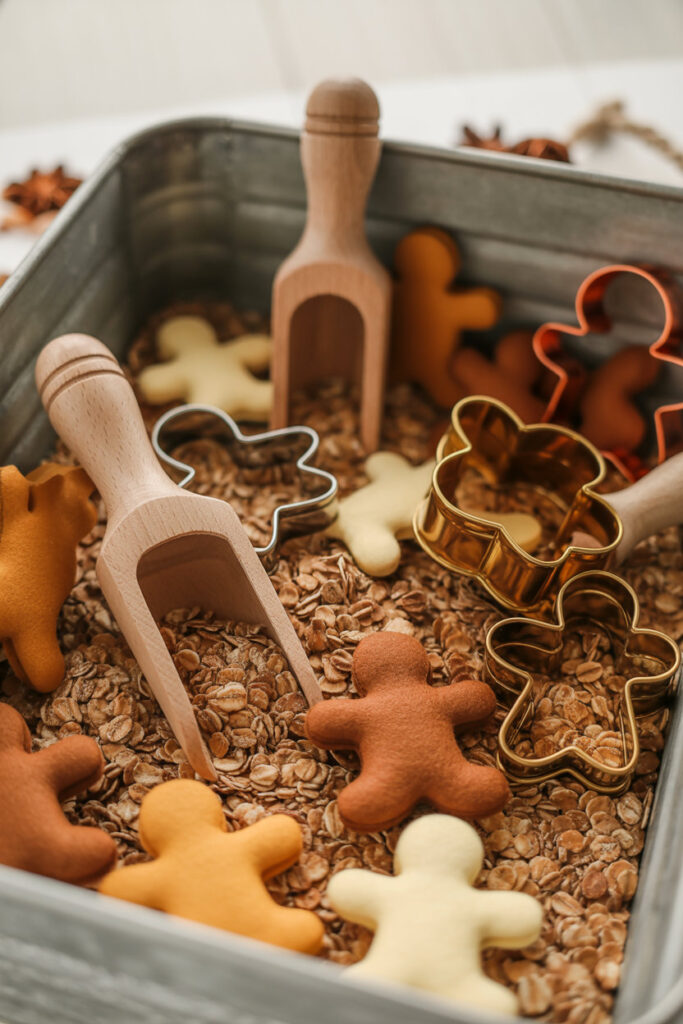
This warm, festive bin feels like stepping into a holiday bakery. Use cinnamon oats or oat flour as the base—soft, scented, and perfect for scooping. Add gingerbread cookie cutters, silicone cups, wooden scoops, and felt “cookies” for shaping and pretend-play baking.
The scent alone draws kids in, but the true magic lies in the open-ended play possibilities. They sift, pour, stamp, and create little cookie scenes that build fine-motor strength while tapping into seasonal nostalgia. It’s ideal for December afternoons or anytime you want holiday magic without the mess of real baking.
Helpful tools: gingerbread cookie cutters, wooden scoops, silicone cups.
Winter Hat Texture Bin

This cozy, tactile bin is inspired by the soft, layered textures of winter clothing. Gather fleece scraps, faux fur pieces, yarn strands, buttons, pom-poms, and felt cutouts shaped like mittens or hats. Spread them across a neutral base like cotton batting to create a gentle, touch-friendly landscape.
Kids naturally explore the contrast between smooth, fuzzy, and plush materials while practicing sorting, matching, and simple pretend play (“Which hat belongs to which doll?”). This bin ties beautifully into your Winter Hat Sensory Bag post and gives little ones a soft sensory break on cold days.
Helpful tools: fleece scraps, large pom-poms, assorted buttons.
Snowball Transfer Station
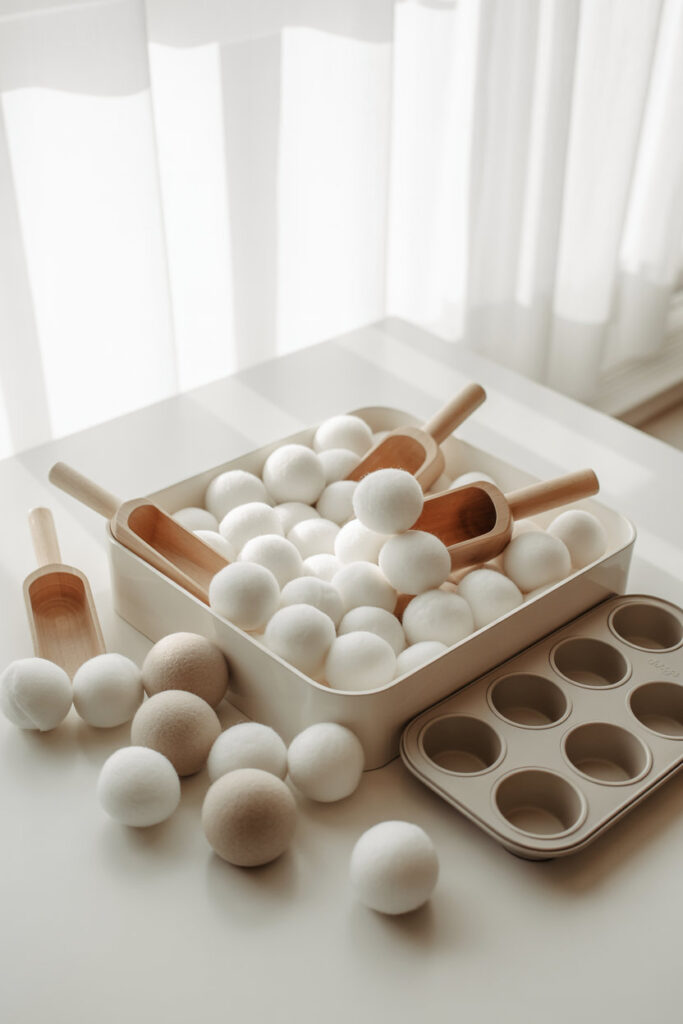
This simple, rhythmic activity feels like a winter-themed fine-motor workout. Fill the bin with cotton balls, felt balls, or soft pom-poms to represent “snowballs.” Add scoops, ice-cream spoons, silicone cups, and a muffin tray for sorting. Children love transferring the “snowballs” from one container to the next in gentle, repetitive motions.
It’s incredibly soothing while strengthening hand muscles and early math concepts like counting, grouping, and comparing sizes. For kids who enjoy structure, create little “snowball challenges” such as filling one cup with only big snowballs or sorting by color.
Helpful tools: felt balls, scoops, silicone muffin tray.
Frozen Ocean Layers Bin

This dramatic, multi-layer sensory bin blends land, sea, and ice into one dreamy scene. Use blue gelatin or frozen water slabs as the “ocean,” then pair it with a rice or cotton “shoreline.” Add arctic animals, smooth stones, and clear gems to create a frozen shoreline little ones can discover and explore.
The layered textures spark rich storytelling—kids guide animals through icy water, dig through “snow,” and rearrange shoreline elements. It’s visually stunning and full of sensory contrast, making it a standout winter activity.
Helpful tools: arctic figurines, clear gems, sectioned sensory tray.
Evergreen Sensory Soup

This bin captures the cozy scent and vibe of winter forests. Fill a container with warm water (just a little cooler than bath temperature) and add evergreen clippings, pinecones, wooden spoons, and ladles. Kids stir, scoop, and swirl everything into a fragrant “winter soup.”
The gentle aromas make this especially calming, and the movement of objects through the water helps toddlers explore buoyancy and flow. Keep a towel nearby and always supervise water play closely.
Helpful tools: wooden ladles, water play tools, small pinecones.
Winter Light & Shadow Bin
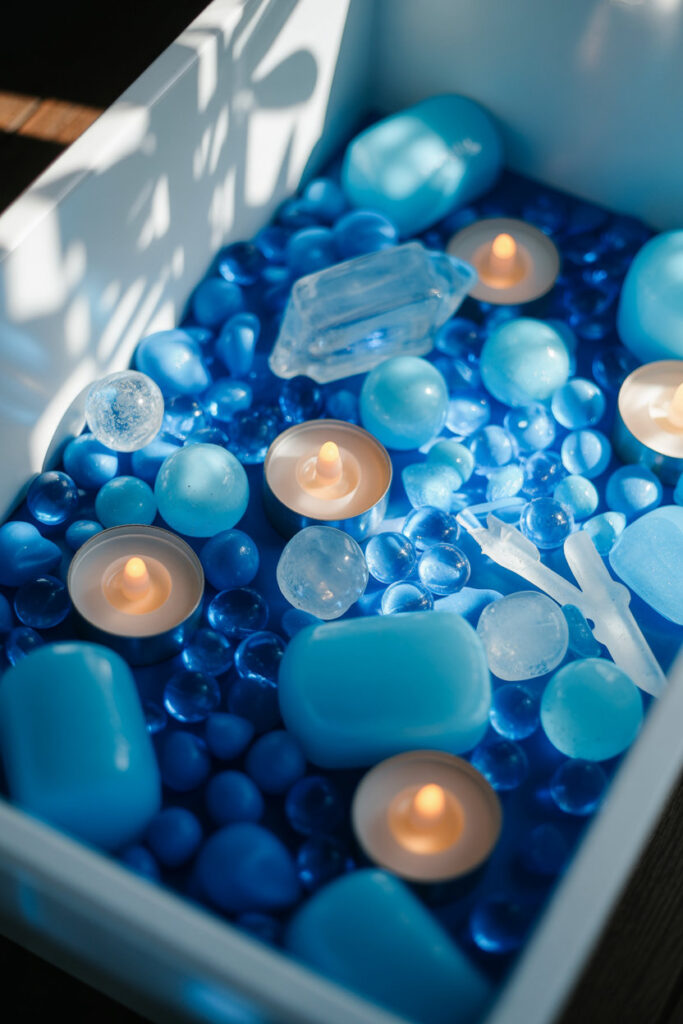
This luminous, modern sensory bin is all about soft glow and gentle discovery. Place battery-operated LED tea lights (secured safely under a mesh or plastic grate), then layer translucent manipulatives, blue acrylic pieces, and clear blocks on top. Dim the lights slightly to let the glowing elements shine.
Kids experiment with stacking, color mixing, and positioning objects to see how the glow shifts. It’s a mesmerizing, calming activity—perfect for winding down or transforming late-afternoon play into something magical.
Helpful tools: LED tea lights, translucent manipulatives, light-play blocks.
Sensory Play Safety & Cleanup Made Beautiful
Winter sensory play can be peaceful and magical, and a few thoughtful safety habits keep it that way. Always supervise your child closely, especially when water, ice, or small objects are involved. Choose materials that match your child’s developmental stage—bigger pieces for younger toddlers and more detailed tools for older ones. When working with scented or natural items like pine or spices, offer them in ways that avoid accidental tastes or irritation.
Cleanup becomes much easier when the setup is intentional. Place a silicone mat, towel, or tray under the bin to catch stray materials, and keep a damp cloth nearby for quick resets. Store winter sensory items in clear, labeled bins so you can pull everything out in seconds without searching through cupboards. Treat your sensory supplies like a curated seasonal collection—organized, ready, and beautiful enough to enjoy each time you bring them out.
Helpful cleanup tools: silicone play mats, clear storage bins, soft washcloths.
Developmental Benefits of Winter Sensory Bins
Winter sensory bins aren’t just beautiful—they’re quietly powerful for a child’s development. The combination of textures, temperatures, and colors invites toddlers to explore with curiosity, building fine-motor strength as they scoop, pour, pinch, and sort. These small motions strengthen the muscles used for writing, dressing, and everyday independence. The seasonal twist adds novelty, helping children stay engaged longer and deepening the learning that naturally happens through play.
Sensory bins also support emotional regulation. Cool textures like ice or instant snow offer calming input, while warm, cozy themes like “hot cocoa shops” or gingerbread bins appeal to comfort and familiarity. As children narrate what they’re doing—placing a polar bear on an iceberg or stirring a pine-scented soup—they build language, storytelling skills, and early science understanding through real-time cause-and-effect.
Winter sensory play connects beautifully to broader developmental research: Zero to Three highlights sensory exploration as foundational to brain development, and the CDC emphasizes hands-on experimentation in early milestones. It’s a seasonally fresh, aesthetically rich way to support learning while keeping play fun, grounded, and engaging—especially during long winter days indoors.
For more hands-on ideas, explore seasonal inspiration like St. Patrick’s Day sensory bins, Easter sensory bins, and spring sensory setups to carry the magic through the year.
Planning Questions
How many sensory bins should a toddler use per week?
There’s no perfect number—toddlers thrive on variety, not volume. Two to three sensory bins per week is plenty for most families, especially if the themes rotate. The goal is to keep play feeling fresh without overwhelming your child or your routine. Follow their interest, and repeat favorites as often as they ask.
What age is best for winter sensory bins?
Most winter sensory bins work beautifully for children 18 months and up, as long as the materials are safe for their stage. Younger toddlers benefit from simple, large pieces and soft textures, while older toddlers and preschoolers can enjoy more detailed setups like ice-play or small-world scenes. Always supervise closely when water, ice, or small parts are involved. Adjust and simplify as needed to fit your child’s comfort level.
How long should a sensory bin stay out?
Many families keep a sensory bin available for 2–3 days before rotating, especially when using dry materials like rice or pom-poms. If your child loses interest sooner, simply refresh the tools or add a small twist to reignite curiosity. Water or ice-based bins are best enjoyed in one session, but can be reset easily for a second round later in the day.
How do I store seasonal sensory materials?
Store everything in clear, labeled bins—think “Winter Textures,” “Loose Parts,” or “Water Play Tools.” Keeping seasonal materials grouped together makes setup effortless and visually appealing. This also protects items like instant snow, pom-poms, or nature pieces so they’re ready whenever inspiration strikes. A small shelf or closet basket works perfectly for rotating through the seasons.
What if my child tries to taste the materials?
If your child is still mouthing objects, switch to taste-safe bases like oats, cereal, pasta, gelatin, or ice. Offer larger pieces that eliminate choking hazards and keep dramatic-play elements simple. As children mature, gradually introduce more textures while reinforcing gentle reminders about “looking and touching, not tasting.” Sensory play should always feel safe, relaxing, and stress-free for both of you.
Conclusion
Winter sensory play has a way of transforming even the chilliest days into something warm, intentional, and quietly magical. These bins invite children to explore shimmering textures, icy scenes, soft winter fabrics, and cozy dramatic-play moments—all while building meaningful skills through hands-on discovery. Whether you’re leaning into snowy small worlds or savoring the comfort of gingerbread-scented oats, each idea offers a simple way to bring beauty and learning into your home this season.
Let these bins become part of your winter rhythm—pulled out on slow mornings, reset on cozy afternoons, or saved for those high-energy moments when your toddler needs a calming, tactile outlet. With a few thoughtful materials stored in a labeled bin, you’ll always have an easy, enriching activity ready to go. And as the seasons shift, you can carry the magic forward with new ideas that keep curiosity alive all year long.
Save these winter sensory bin ideas to your seasonal activity board so you can revisit them anytime the snow starts to fall—or whenever your toddler needs a little winter magic indoors.
